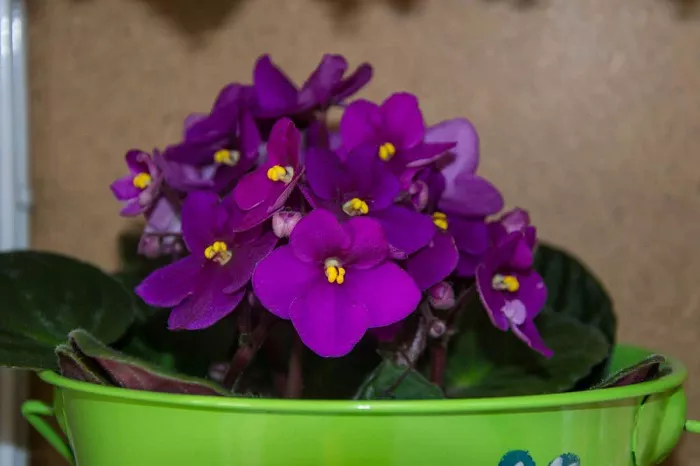African violets are beloved for their vibrant blooms and lush foliage. Yet, many gardeners find themselves puzzled when their plants fail to flower. This guide will walk you through the essential steps to encourage these charming plants to produce an abundance of blossoms. From understanding their light needs to mastering the art of watering, we’ll cover everything you need to know to see your African violets in full bloom.
Understanding the Basics
Light: The Key to Blooming
African violets thrive in bright, indirect light. Place them near an east or north-facing window to ensure they receive ample light without being scorched by direct sun rays. If natural light is insufficient, consider using grow lights. Ensure they receive about 12 to 14 hours of light daily. This consistent light exposure is crucial for triggering the flowering process.
Temperature and Humidity: A Comfortable Environment
These plants prefer a warm and humid environment. Maintain a temperature range of 65 to 75 degrees Fahrenheit (18 to 24 degrees Celsius) for optimal growth. Avoid placing them near drafts or air conditioning vents. To boost humidity, place a tray of water with pebbles under the pot, ensuring the pot does not sit directly in the water. This setup helps create a moist microclimate around the plant.
Watering: The Right Technique
When and How to Water
Proper watering is vital for African violets. Overwatering can lead to root rot, while underwatering can stress the plant. Water only when the top inch of soil feels dry to the touch. Use room temperature water to avoid shocking the roots. It’s best to water from the bottom by placing the pot in a shallow dish of water for about 30 minutes, allowing the soil to absorb moisture through the drainage holes. Remove the pot from the water once the soil surface is moist.
Water Quality Matters
The quality of water you use can impact your plant’s health. Avoid using water that contains chlorine or fluoride, as these chemicals can harm the plant. If your tap water is treated, let it sit out overnight to allow the chemicals to dissipate before using it. Alternatively, you can use distilled or rainwater for a healthier option.
Soil and Fertilizer: Nourishing Your Plant
Choosing the Right Soil
African violets require well-draining soil that retains some moisture. A potting mix specifically designed for African violets is ideal, as it provides the right balance of nutrients and drainage. Ensure the soil is light and airy to allow for proper root aeration. You can also make your own mix by combining peat moss, perlite, and vermiculite in equal parts.
Fertilizing for Blooms
Regular feeding is essential for continuous blooming. Use a balanced, water-soluble fertilizer specifically formulated for African violets. Apply the fertilizer every two to four weeks during the growing season, following the package instructions for the correct dilution. Avoid over-fertilizing, as this can lead to excessive foliage growth at the expense of blooms.
Pruning and Grooming: Encouraging Healthy Growth
Removing Dead Leaves and Flowers
Regular pruning helps maintain the plant’s health and encourages new growth. Remove any dead or yellowing leaves, as well as spent flower stalks. This not only improves the plant’s appearance but also redirects energy towards new blooms. Be gentle when handling the leaves to avoid damaging the plant.
Pinching for Fuller Plants
Pinching back the tips of new growth can help create a fuller, bushier plant. This technique encourages branching and leads to more flowering sites. Simply pinch off the top inch of new growth when the plant is young. As it matures, continue to remove any leggy stems to maintain a compact shape.
Common Issues and Solutions
Pests and Diseases
African violets are generally hardy, but they can be susceptible to pests like mealybugs and aphids. Inspect your plant regularly for signs of infestation. If you spot any pests, treat the plant with a mild insecticidal soap. Overwatering can also lead to root rot, so always ensure proper drainage and avoid letting the plant sit in water.
Troubleshooting Blooming Problems
If your African violet is not flowering, it could be due to insufficient light, improper watering, or lack of nutrients. Reevaluate the plant’s light exposure and adjust accordingly. Check your watering schedule and ensure you’re using the right soil and fertilizer. Sometimes, a change in environment or a slight adjustment in care can make all the difference.
Special Tips for Success
Repotting and Propagation
Repot your African violet every year or when it outgrows its current pot. Use a pot that is only slightly larger than the current one to avoid overpotting. When repotting, gently remove the plant from its pot, trim any dead roots, and place it in fresh soil. African violets can also be easily propagated from leaf cuttings. Simply cut a healthy leaf with a small piece of stem and place it in moist potting mix. Keep the soil moist and in a few weeks, you’ll see new plantlets forming.
Seasonal Care
During the winter months, African violets may slow down in growth. Reduce watering slightly and avoid fertilizing during this period. As spring approaches, gradually increase light exposure and resume regular feeding to encourage new growth and blooms.
Conclusion
Encouraging African violets to flower is a rewarding process that requires attention to their specific needs. By providing the right light, maintaining optimal temperature and humidity, using proper watering techniques, and ensuring they receive the right nutrients, you can enjoy an abundance of beautiful blooms. With a little patience and care, these charming plants will brighten up your home with their vibrant colors.


